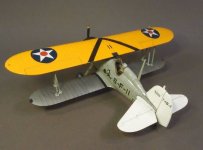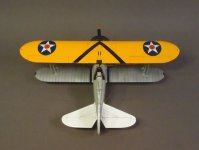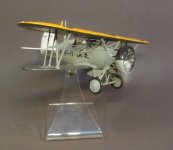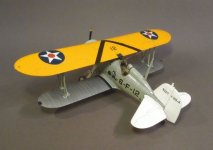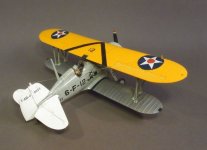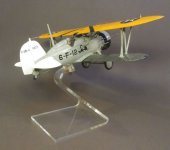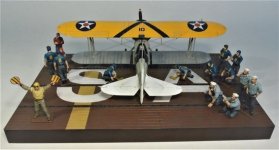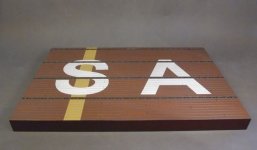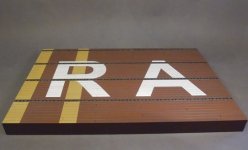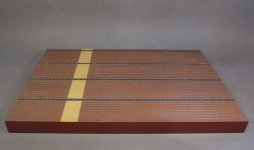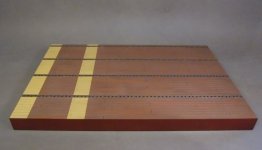INTER-WAR AVIATION
The Interwar Aviation series covers aircraft that were developed and used between World War 1 and World War 2, and was known as the “Golden Age of Aviation.”
In the two decades between the end of World War 1 and the start of World War 2, military aviation underwent a complete transformation. The typical combat aircraft of 1918 was a fabric-covered externally braced biplane with fixed landing gear and open cockpits. Few aero engines developed as much as 250 horsepower, and top speeds of 200 km (120 miles) per hour were exceptional. By 1939 the first-line combat aircraft of the major powers were all-metal monoplanes with retractable landing gear.
The Boeing P-12/F4B was an American pursuit aircraft that was operated by the United States Army Air Corps and United States Navy.
Though best known in later years for producing large bomber or transport aircraft, Boeing produced a series of excellent fighters from 1923 to 1933. The most famous of those biplane fighters, the F4B, was the refinement of design experience gained from its FB, F2B and F3B predecessors.
Nimble, rugged and reliable, the F4B-4's debut coincided nicely with advances in carrier operations aboard the new carriers Lexington (CV-2) and Saratoga (CV-3). The aircraft remained the Navy and Marine Corps' first-line fighter until replaced by faster and more powerful Grumman biplanes.
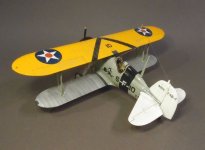
IWA-10
INTER-WAR AVIATION,
BOEING F4B-4 A-9020,
FIGHTING SQUADRON SIX (VF-6B),
SECTION LEADER, SECTION 4,
USS SARATOGA (CV-3) 1935.
(2pcs)
VF-6B, known as the “Fighting Six” had as their mascot, “Felix The Cat”, a well known cartoon character of the time. The lit bomb he carries relates to when the squadron first started as a Bombing Squadron in 1929. “Felix The Cat” is one of the longest serving squadron insignia in the US Navy.
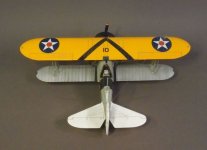
The white tails of the aircraft were the squadron’s carrier identification colour during their service aboard the USS Saratoga.
The Navy Bureau Number (BuNo.) 9020 was the Section Leader in the Squadron’s Fourth Section, whose identification colour was black.
The Section leader carried a full black cowl, the second aircraft displayed a top half black cowl, and the third a bottom half black cowl.
All aircraft displayed wing chevrons in the section colour, and their individual aircraft number on their upperwing.
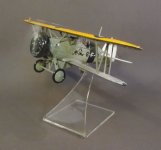
SECTION MARKINGS OF SQUADRONS
In December 1930, the US Bureau of Aeronautics directed that all aircraft under construction be painted using a scheme of section markings that would visually identify their position in the squadron.
The normal squadron strength was 18 aircraft.
This was divided into two divisions of three sections, and each section was made up of three aircraft.
The first division was made up of sections, 1,2,3 and the second division was made up of sections 4,5,and 6.
Normally the squadron Commander would lead the first division as Section Leader of Section 1, and his Executive officer would lead the second division as Section Leader of Section 4.
More to follow...............................................
The Interwar Aviation series covers aircraft that were developed and used between World War 1 and World War 2, and was known as the “Golden Age of Aviation.”
In the two decades between the end of World War 1 and the start of World War 2, military aviation underwent a complete transformation. The typical combat aircraft of 1918 was a fabric-covered externally braced biplane with fixed landing gear and open cockpits. Few aero engines developed as much as 250 horsepower, and top speeds of 200 km (120 miles) per hour were exceptional. By 1939 the first-line combat aircraft of the major powers were all-metal monoplanes with retractable landing gear.
The Boeing P-12/F4B was an American pursuit aircraft that was operated by the United States Army Air Corps and United States Navy.
Though best known in later years for producing large bomber or transport aircraft, Boeing produced a series of excellent fighters from 1923 to 1933. The most famous of those biplane fighters, the F4B, was the refinement of design experience gained from its FB, F2B and F3B predecessors.
Nimble, rugged and reliable, the F4B-4's debut coincided nicely with advances in carrier operations aboard the new carriers Lexington (CV-2) and Saratoga (CV-3). The aircraft remained the Navy and Marine Corps' first-line fighter until replaced by faster and more powerful Grumman biplanes.

IWA-10
INTER-WAR AVIATION,
BOEING F4B-4 A-9020,
FIGHTING SQUADRON SIX (VF-6B),
SECTION LEADER, SECTION 4,
USS SARATOGA (CV-3) 1935.
(2pcs)
VF-6B, known as the “Fighting Six” had as their mascot, “Felix The Cat”, a well known cartoon character of the time. The lit bomb he carries relates to when the squadron first started as a Bombing Squadron in 1929. “Felix The Cat” is one of the longest serving squadron insignia in the US Navy.

The white tails of the aircraft were the squadron’s carrier identification colour during their service aboard the USS Saratoga.
The Navy Bureau Number (BuNo.) 9020 was the Section Leader in the Squadron’s Fourth Section, whose identification colour was black.
The Section leader carried a full black cowl, the second aircraft displayed a top half black cowl, and the third a bottom half black cowl.
All aircraft displayed wing chevrons in the section colour, and their individual aircraft number on their upperwing.

SECTION MARKINGS OF SQUADRONS
In December 1930, the US Bureau of Aeronautics directed that all aircraft under construction be painted using a scheme of section markings that would visually identify their position in the squadron.
The normal squadron strength was 18 aircraft.
This was divided into two divisions of three sections, and each section was made up of three aircraft.
The first division was made up of sections, 1,2,3 and the second division was made up of sections 4,5,and 6.
Normally the squadron Commander would lead the first division as Section Leader of Section 1, and his Executive officer would lead the second division as Section Leader of Section 4.
More to follow...............................................


